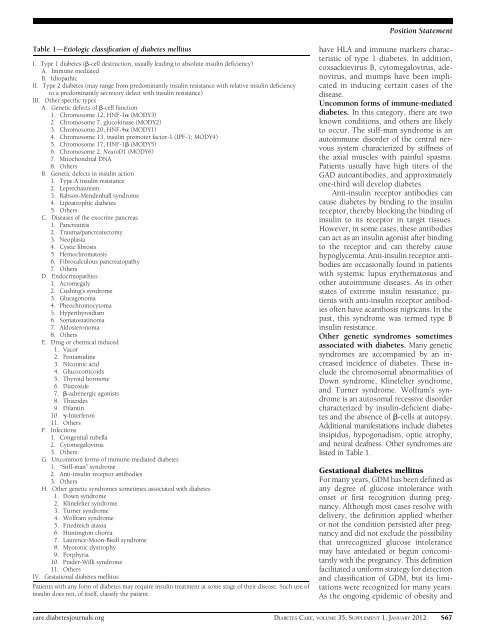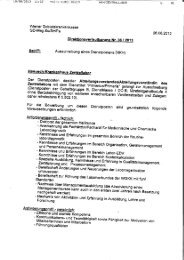Diagnosis and Classification of Diabetes Mellitus
Diagnosis and Classification of Diabetes Mellitus
Diagnosis and Classification of Diabetes Mellitus
Create successful ePaper yourself
Turn your PDF publications into a flip-book with our unique Google optimized e-Paper software.
Position Statement<br />
Table 1dEtiologic classification <strong>of</strong> diabetes mellitus<br />
I. Type 1 diabetes (b-cell destruction, usually leading to absolute insulin deficiency)<br />
A. Immune mediated<br />
B. Idiopathic<br />
II. Type 2 diabetes (may range from predominantly insulin resistance with relative insulin deficiency<br />
to a predominantly secretory defect with insulin resistance)<br />
III. Other specific types<br />
A. Genetic defects <strong>of</strong> b-cell function<br />
1. Chromosome 12, HNF-1a (MODY3)<br />
2. Chromosome 7, glucokinase (MODY2)<br />
3. Chromosome 20, HNF-4a (MODY1)<br />
4. Chromosome 13, insulin promoter factor-1 (IPF-1; MODY4)<br />
5. Chromosome 17, HNF-1b (MODY5)<br />
6. Chromosome 2, NeuroD1 (MODY6)<br />
7. Mitochondrial DNA<br />
8. Others<br />
B. Genetic defects in insulin action<br />
1. Type A insulin resistance<br />
2. Leprechaunism<br />
3. Rabson-Mendenhall syndrome<br />
4. Lipoatrophic diabetes<br />
5. Others<br />
C. Diseases <strong>of</strong> the exocrine pancreas<br />
1. Pancreatitis<br />
2. Trauma/pancreatectomy<br />
3. Neoplasia<br />
4. Cystic fibrosis<br />
5. Hemochromatosis<br />
6. Fibrocalculous pancreatopathy<br />
7. Others<br />
D. Endocrinopathies<br />
1. Acromegaly<br />
2. Cushing’s syndrome<br />
3. Glucagonoma<br />
4. Pheochromocytoma<br />
5. Hyperthyroidism<br />
6. Somatostatinoma<br />
7. Aldosteronoma<br />
8. Others<br />
E. Drug or chemical induced<br />
1. Vacor<br />
2. Pentamidine<br />
3. Nicotinic acid<br />
4. Glucocorticoids<br />
5. Thyroid hormone<br />
6. Diazoxide<br />
7. b-adrenergic agonists<br />
8. Thiazides<br />
9. Dilantin<br />
10. g-Interferon<br />
11. Others<br />
F. Infections<br />
1. Congenital rubella<br />
2. Cytomegalovirus<br />
3. Others<br />
G. Uncommon forms <strong>of</strong> immune-mediated diabetes<br />
1. “Stiff-man” syndrome<br />
2. Anti-insulin receptor antibodies<br />
3. Others<br />
H. Other genetic syndromes sometimes associated with diabetes<br />
1. Down syndrome<br />
2. Klinefelter syndrome<br />
3. Turner syndrome<br />
4. Wolfram syndrome<br />
5. Friedreich ataxia<br />
6. Huntington chorea<br />
7. Laurence-Moon-Biedl syndrome<br />
8. Myotonic dystrophy<br />
9. Porphyria<br />
10. Prader-Willi syndrome<br />
11. Others<br />
IV. Gestational diabetes mellitus<br />
Patients with any form <strong>of</strong> diabetes may require insulin treatment at some stage <strong>of</strong> their disease. Such use <strong>of</strong><br />
insulin does not, <strong>of</strong> itself, classify the patient.<br />
have HLA <strong>and</strong> immune markers characteristic<br />
<strong>of</strong> type 1 diabetes. In addition,<br />
coxsackievirus B, cytomegalovirus, adenovirus,<br />
<strong>and</strong> mumps have been implicated<br />
in inducing certain cases <strong>of</strong> the<br />
disease.<br />
Uncommon forms <strong>of</strong> immune-mediated<br />
diabetes. In this category, there are two<br />
known conditions, <strong>and</strong> others are likely<br />
to occur. The stiff-man syndrome is an<br />
autoimmune disorder <strong>of</strong> the central nervous<br />
system characterized by stiffness <strong>of</strong><br />
the axial muscles with painful spasms.<br />
Patients usually have high titers <strong>of</strong> the<br />
GAD autoantibodies, <strong>and</strong> approximately<br />
one-third will develop diabetes.<br />
Anti-insulin receptor antibodies can<br />
cause diabetes by binding to the insulin<br />
receptor, thereby blocking the binding <strong>of</strong><br />
insulin to its receptor in target tissues.<br />
However, in some cases, these antibodies<br />
can act as an insulin agonist after binding<br />
to the receptor <strong>and</strong> can thereby cause<br />
hypoglycemia. Anti-insulin receptor antibodies<br />
are occasionally found in patients<br />
with systemic lupus erythematosus <strong>and</strong><br />
other autoimmune diseases. As in other<br />
states <strong>of</strong> extreme insulin resistance, patients<br />
with anti-insulin receptor antibodies<br />
<strong>of</strong>ten have acanthosis nigricans. In the<br />
past, this syndrome was termed type B<br />
insulin resistance.<br />
Other genetic syndromes sometimes<br />
associated with diabetes. Many genetic<br />
syndromes are accompanied by an increased<br />
incidence <strong>of</strong> diabetes. These include<br />
the chromosomal abnormalities <strong>of</strong><br />
Down syndrome, Klinefelter syndrome,<br />
<strong>and</strong> Turner syndrome. Wolfram’s syndrome<br />
is an autosomal recessive disorder<br />
characterized by insulin-deficient diabetes<br />
<strong>and</strong> the absence <strong>of</strong> b-cells at autopsy.<br />
Additional manifestations include diabetes<br />
insipidus, hypogonadism, optic atrophy,<br />
<strong>and</strong> neural deafness. Other syndromes are<br />
listedinTable1.<br />
Gestational diabetes mellitus<br />
For many years, GDM has been defined as<br />
any degree <strong>of</strong> glucose intolerance with<br />
onset or first recognition during pregnancy.<br />
Although most cases resolve with<br />
delivery, the definition applied whether<br />
or not the condition persisted after pregnancy<br />
<strong>and</strong> did not exclude the possibility<br />
that unrecognized glucose intolerance<br />
may have antedated or begun concomitantly<br />
with the pregnancy. This definition<br />
facilitated a uniform strategy for detection<br />
<strong>and</strong> classification <strong>of</strong> GDM, but its limitations<br />
were recognized for many years.<br />
As the ongoing epidemic <strong>of</strong> obesity <strong>and</strong><br />
care.diabetesjournals.org DIABETES CARE, VOLUME 35, SUPPLEMENT 1, JANUARY 2012 S67




